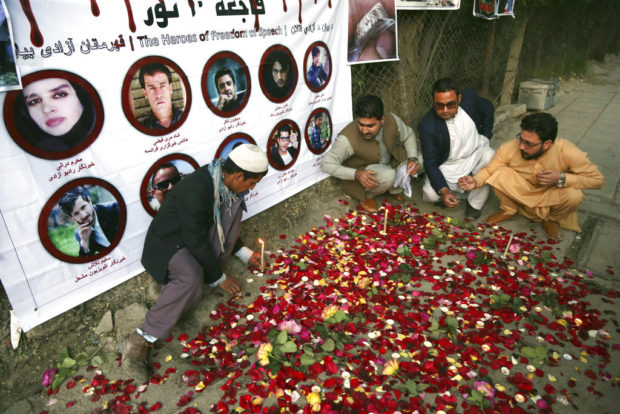53 journalists killed worldwide so far in 2018 — report

In this May 3, 2018 file photo, Afghan residents light candles to pay tribute to Afghan journalists killed three days earlier in a suicide attack in Kabul, Afghanistan. (Photo RAHMAT GUL / AP)
NEW YORK — The number of journalists killed worldwide in retaliation for their work nearly doubled this year, according to an annual report by the Committee to Protect Journalists.
The New York-based organization found that 34 journalists were killed in retaliation for their work as of Dec. 14, while at least 53 were killed overall.
That compares to 18 retaliation killings among the 47 deaths documented by the committee in 2017.
The report issued Wednesday includes the killing of Washington Post columnist Jamal Khashoggi, a native of Saudi Arabia fiercely critical of its royal regime.
His Oct. 2 death inside the Saudi consulate in Istanbul has led to tremors on the global political scene around allegations that Saudi Crown Prince Mohammed bin Salman was involved.
Article continues after this advertisementKhashoggi lived in self-imposed exile in the United States, and had gone to the Saudi consulate to formalize his divorce, but was instead strangled and dismembered — allegedly by Saudi agents.
Article continues after this advertisementAsked whether he believed the crown prince had ordered Khashoggi’s murder, President Donald Trump said last month, “Maybe he did and maybe he didn’t.”
While the president condemned the violence against journalists, the committee noted that he has called them “enemies of the people.”
In addition to retaliation killings, journalists have died in combat or crossfire, or on other dangerous assignments.
The deadliest country for journalists this year has been Afghanistan, where 13 journalists were killed, some in back-to-back blasts staged by suicide bombers and claimed by the militant group Islamic State, according to the report.
Media freedom group Reporters Without Borders said Tuesday that the U.S. made it into the top five deadliest countries for journalists this year for the first time, with six dying, including four who were among five people killed by a gunman who opened fire in the offices of Maryland newspaper Capital Gazette on June 28.
The shooting was the deadliest single attack on the media in recent U.S. history. A sales associate was also killed. The man had threatened the newspaper after losing a defamation lawsuit. Another two died while covering extreme weather.
In addition, the committee said the imprisonment of journalists has been on the rise.
“The context for the crisis is varied and complex, and closely tied to changes in technology that have allowed more people to practice journalism even as it has made journalists expendable to the political and criminal groups who once needed the news media to spread their message,” the committee said in its report.
Time magazine last week recognized jailed and killed journalists as its Person of the Year, including Khashoggi, Maria Ressa imprisoned in the Philippines, Wa Lone and Kyaw Soe Oo imprisoned in Myanmar, and staff at the Capital Gazette.
Journalists also have died this year in Slovakia, where 27-year-old investigative reporter Jan Kuciak was fatally shot while probing alleged corruption, and in Malta, where Daphne Caruana Galizia, on a similar mission, was killed by a bomb placed in her car.
At least four journalists were murdered in Mexico, two in Brazil, and two Palestinian journalists were shot and killed by Israeli soldiers during protests in the Gaza Strip, according to the report.
In Syria and Yemen, two of the worst civil-war decimated countries, the fewest journalists were killed since 2011. Three died in Yemen, and in Syria, the committee recorded nine deaths compared to a high of 31 in 2012.
However, the drop may be due to limited access or extreme risks that discourage media visits, the committee said.